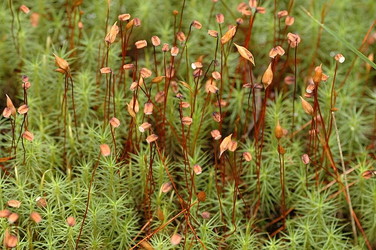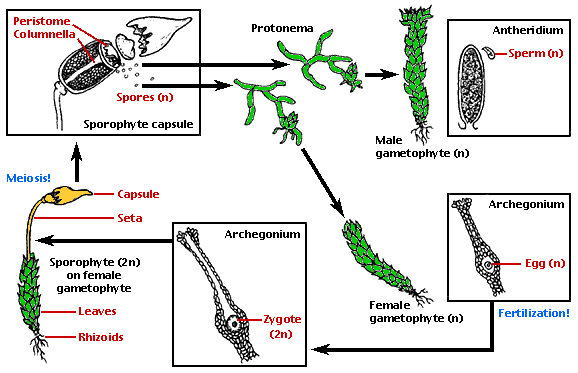Moss. What comes to mind when you hear “moss”? Probably an image of that useless green fuzz you see on rocks when you’re hiking or in your neighbor’s garden, but there is more to moss then meets the eye. By looking over this website you will find the answers to questions you never even thought to ask about an organism as seemingly boring as moss. Next time you come across that bit of green fuzz you will not leave unimpressed.


Polytrichum commune. © James K. Lindsey
Appearance
With a distinct appearance the Common Hair Cap Moss gets its name from the hairs that cover, or cap, the calyptra where each spore case is held (1). Looking down on it, the Common Hair Cap Moss has a star shaped appearance because of the pointed leaves arranged spirally at right angles around a stiff stem (3). Like other mosses, it is generally a dark green colour and doesn’t grow very tall. The Common Hair Cap Moss has no woody tissue so it only grows from 4-20cm tall (2). Growing like a lush green carpet, the average life span of this moss is three to five years, although ten has been recorded, and even dead the moss remains intact, and is what makes up the lower portion of this organism (7).
Habitat
Living all over the world both in the wild and as decorative ground coverings in personal gardens Common Hair Cap Moss is easy to find. Preferring to live in lightly shaded areas with moist slightly acidic soil, it can also survive in areas of full sunlight provided the soil is moist (2). The Common Hair Cap Moss can also grow in areas of poor soil and slow drainage. These characteristics make this moss a good plant for all types of gardens and gardeners. In gardens of Japan, where mosses are used commonly, the Common Hair Cap Moss is used more than any other species combined. In the wild it grows in many places, from granite outcrops to the coastal plain to the banks of ponds or lakes. With the ability to grow in a diversity of habitats, Common Hair Cap Moss is seen all over the world.
Reproduction
Although the Common Hair Cap Moss has three types of shoots, it is the male and female shoots which are necessary for reproduction. The female shoots develop the eggs and the male shoots develop the sperm. In the spring, raindrops splash the sperm from the male shoots to the female shoots where they then travel into the egg.


© 1997 BIODIDAC. Modified from original drawings by Ivy Livingstone. Life cycle of a dioicous moss.
During the summer spores are released and carried by the wind. When the spore reaches a habitat it can survive in, it germinates and the process starts over again (6).&
Uses
Not just visually pleasing, Common Hair Cap Moss has other uses. It is used by some people to make a tea to dissolve kidney and gall bladder stones (5). Also, this moss is good for hair, so the same tea was used by women as a rinse to strengthen their hair. In the past the stems have been woven and used to make baskets. Like many plants the Common Hair Cap Moss can be useful to humans.
Taxonomy
- Kingdom- Plantae
- Phylum- Bryophyta (Mosses)
- Class- Bryopsida = Musci (True Mosses)
- Subclass- Polytrichidae
- Order- Polytrichales
- Family- Polytrichaceae
- Genus- Polytrichum (Hair-cap Mosses)
- Species- commune (6)
In closing, moss is more important that it may seem. All organisms play a role in the way the world works and even something as small and inconspicuous as Common Hair Cap Moss is valuable.



 Go to quick links
Go to quick search
Go to navigation for this section of the ToL site
Go to detailed links for the ToL site
Go to quick links
Go to quick search
Go to navigation for this section of the ToL site
Go to detailed links for the ToL site